ACC00718: Accounting Information Systems Report Analysis - Fraud
VerifiedAdded on 2022/11/26
|6
|1157
|198
Report
AI Summary
This report provides a comprehensive analysis of accounting information systems, focusing on fraud prevention and detection within a public company setting. The assignment addresses two scenarios. Scenario A explores procedures to mitigate the risk of overpayment due to inflated responses in promotional advertising, emphasizing the importance of invoice verification, segregation of duties, investigation of unusual invoice volumes, and checking invoice details. Scenario B examines internal controls, specifically segregation of duties, as a key mechanism to prevent fraud, and outlines various audit procedures that an auditor would undertake to detect potential fraud, including fraud brainstorming sessions, accounting journal tests, exercising professional skepticism, and investigating unusual transactions. The report references academic sources to support its recommendations, offering practical insights into financial controls and audit practices.
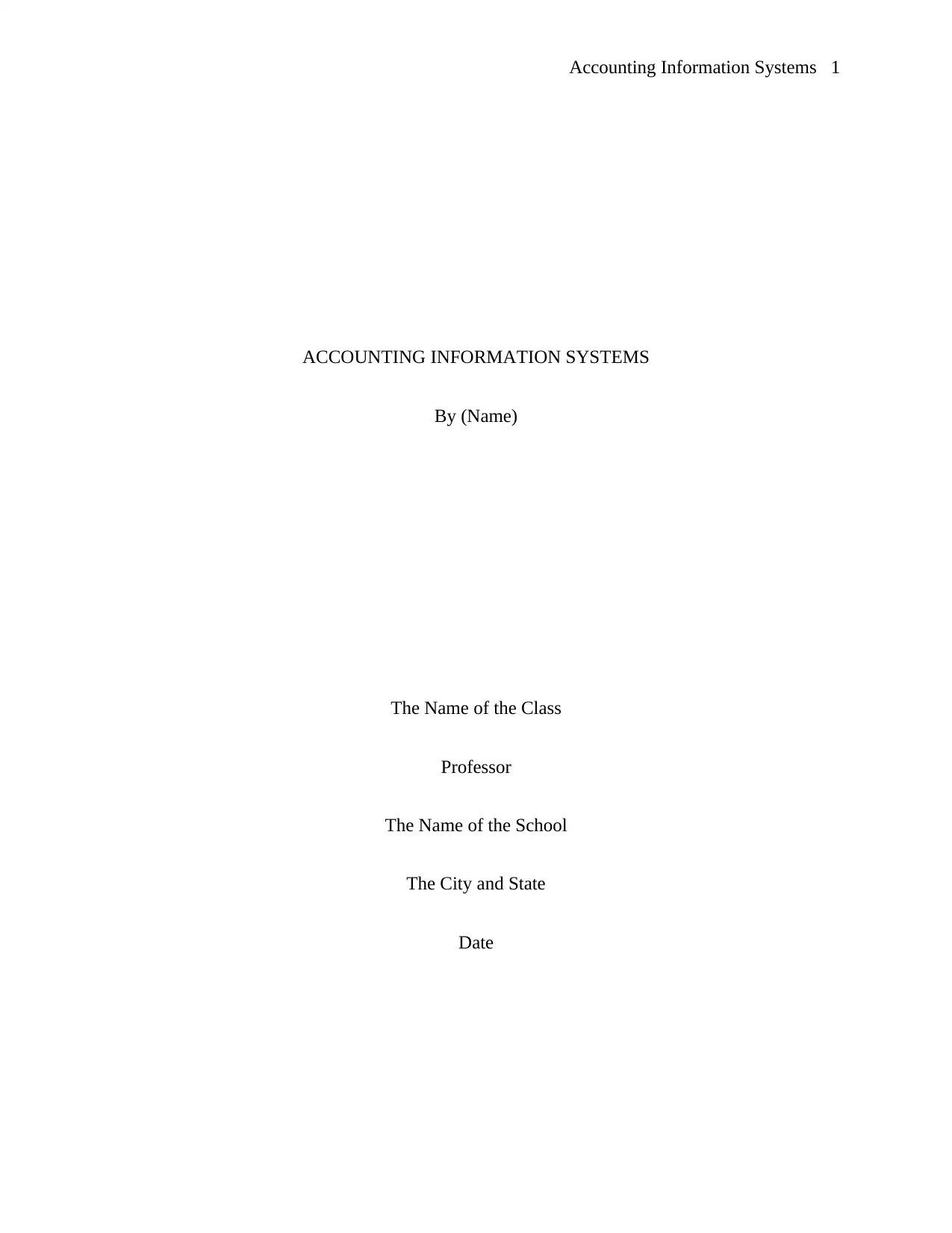
Accounting Information Systems 1
ACCOUNTING INFORMATION SYSTEMS
By (Name)
The Name of the Class
Professor
The Name of the School
The City and State
Date
ACCOUNTING INFORMATION SYSTEMS
By (Name)
The Name of the Class
Professor
The Name of the School
The City and State
Date
Paraphrase This Document
Need a fresh take? Get an instant paraphrase of this document with our AI Paraphraser
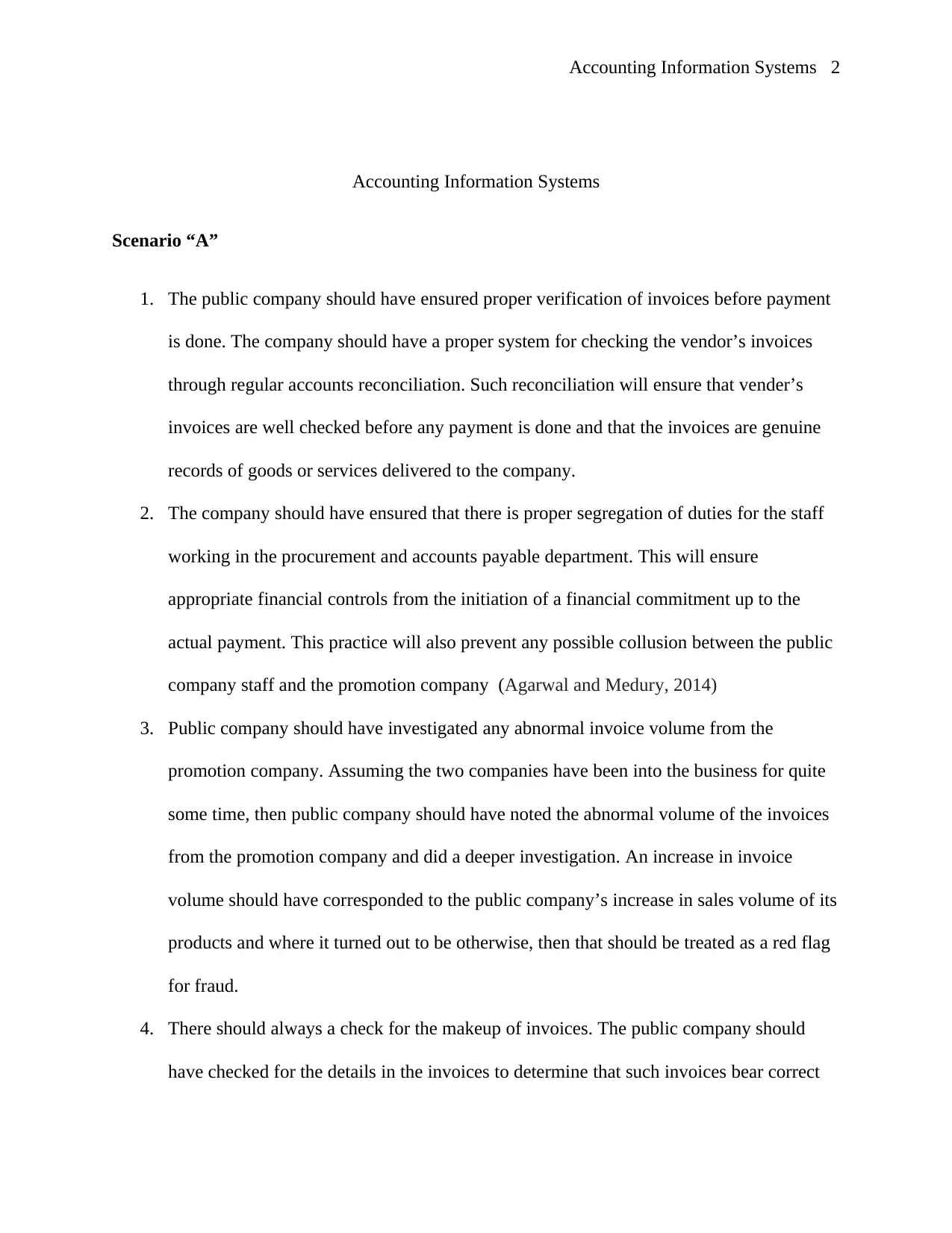
Accounting Information Systems 2
Accounting Information Systems
Scenario “A”
1. The public company should have ensured proper verification of invoices before payment
is done. The company should have a proper system for checking the vendor’s invoices
through regular accounts reconciliation. Such reconciliation will ensure that vender’s
invoices are well checked before any payment is done and that the invoices are genuine
records of goods or services delivered to the company.
2. The company should have ensured that there is proper segregation of duties for the staff
working in the procurement and accounts payable department. This will ensure
appropriate financial controls from the initiation of a financial commitment up to the
actual payment. This practice will also prevent any possible collusion between the public
company staff and the promotion company (Agarwal and Medury, 2014)
3. Public company should have investigated any abnormal invoice volume from the
promotion company. Assuming the two companies have been into the business for quite
some time, then public company should have noted the abnormal volume of the invoices
from the promotion company and did a deeper investigation. An increase in invoice
volume should have corresponded to the public company’s increase in sales volume of its
products and where it turned out to be otherwise, then that should be treated as a red flag
for fraud.
4. There should always a check for the makeup of invoices. The public company should
have checked for the details in the invoices to determine that such invoices bear correct
Accounting Information Systems
Scenario “A”
1. The public company should have ensured proper verification of invoices before payment
is done. The company should have a proper system for checking the vendor’s invoices
through regular accounts reconciliation. Such reconciliation will ensure that vender’s
invoices are well checked before any payment is done and that the invoices are genuine
records of goods or services delivered to the company.
2. The company should have ensured that there is proper segregation of duties for the staff
working in the procurement and accounts payable department. This will ensure
appropriate financial controls from the initiation of a financial commitment up to the
actual payment. This practice will also prevent any possible collusion between the public
company staff and the promotion company (Agarwal and Medury, 2014)
3. Public company should have investigated any abnormal invoice volume from the
promotion company. Assuming the two companies have been into the business for quite
some time, then public company should have noted the abnormal volume of the invoices
from the promotion company and did a deeper investigation. An increase in invoice
volume should have corresponded to the public company’s increase in sales volume of its
products and where it turned out to be otherwise, then that should be treated as a red flag
for fraud.
4. There should always a check for the makeup of invoices. The public company should
have checked for the details in the invoices to determine that such invoices bear correct
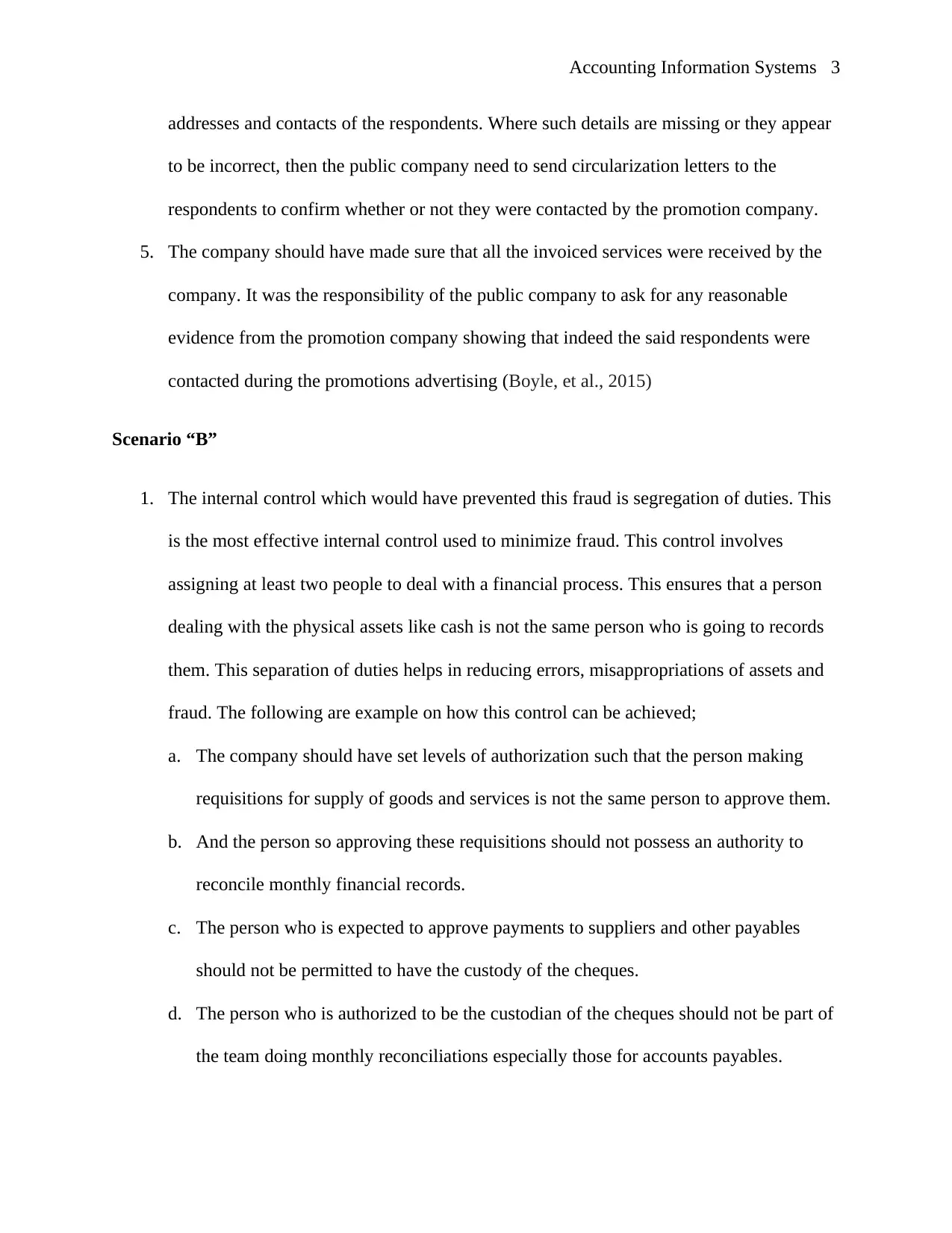
Accounting Information Systems 3
addresses and contacts of the respondents. Where such details are missing or they appear
to be incorrect, then the public company need to send circularization letters to the
respondents to confirm whether or not they were contacted by the promotion company.
5. The company should have made sure that all the invoiced services were received by the
company. It was the responsibility of the public company to ask for any reasonable
evidence from the promotion company showing that indeed the said respondents were
contacted during the promotions advertising (Boyle, et al., 2015)
Scenario “B”
1. The internal control which would have prevented this fraud is segregation of duties. This
is the most effective internal control used to minimize fraud. This control involves
assigning at least two people to deal with a financial process. This ensures that a person
dealing with the physical assets like cash is not the same person who is going to records
them. This separation of duties helps in reducing errors, misappropriations of assets and
fraud. The following are example on how this control can be achieved;
a. The company should have set levels of authorization such that the person making
requisitions for supply of goods and services is not the same person to approve them.
b. And the person so approving these requisitions should not possess an authority to
reconcile monthly financial records.
c. The person who is expected to approve payments to suppliers and other payables
should not be permitted to have the custody of the cheques.
d. The person who is authorized to be the custodian of the cheques should not be part of
the team doing monthly reconciliations especially those for accounts payables.
addresses and contacts of the respondents. Where such details are missing or they appear
to be incorrect, then the public company need to send circularization letters to the
respondents to confirm whether or not they were contacted by the promotion company.
5. The company should have made sure that all the invoiced services were received by the
company. It was the responsibility of the public company to ask for any reasonable
evidence from the promotion company showing that indeed the said respondents were
contacted during the promotions advertising (Boyle, et al., 2015)
Scenario “B”
1. The internal control which would have prevented this fraud is segregation of duties. This
is the most effective internal control used to minimize fraud. This control involves
assigning at least two people to deal with a financial process. This ensures that a person
dealing with the physical assets like cash is not the same person who is going to records
them. This separation of duties helps in reducing errors, misappropriations of assets and
fraud. The following are example on how this control can be achieved;
a. The company should have set levels of authorization such that the person making
requisitions for supply of goods and services is not the same person to approve them.
b. And the person so approving these requisitions should not possess an authority to
reconcile monthly financial records.
c. The person who is expected to approve payments to suppliers and other payables
should not be permitted to have the custody of the cheques.
d. The person who is authorized to be the custodian of the cheques should not be part of
the team doing monthly reconciliations especially those for accounts payables.
⊘ This is a preview!⊘
Do you want full access?
Subscribe today to unlock all pages.

Trusted by 1+ million students worldwide
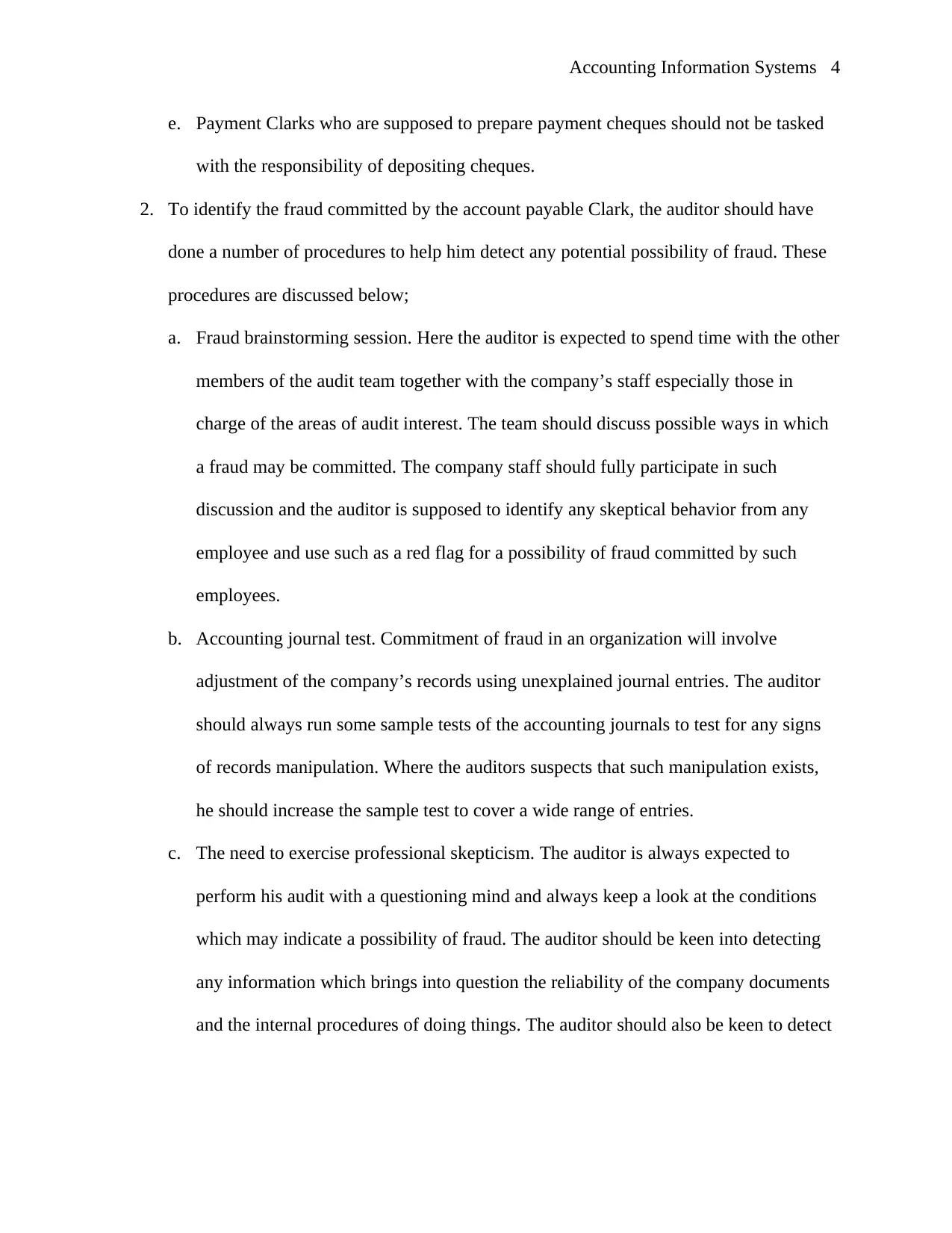
Accounting Information Systems 4
e. Payment Clarks who are supposed to prepare payment cheques should not be tasked
with the responsibility of depositing cheques.
2. To identify the fraud committed by the account payable Clark, the auditor should have
done a number of procedures to help him detect any potential possibility of fraud. These
procedures are discussed below;
a. Fraud brainstorming session. Here the auditor is expected to spend time with the other
members of the audit team together with the company’s staff especially those in
charge of the areas of audit interest. The team should discuss possible ways in which
a fraud may be committed. The company staff should fully participate in such
discussion and the auditor is supposed to identify any skeptical behavior from any
employee and use such as a red flag for a possibility of fraud committed by such
employees.
b. Accounting journal test. Commitment of fraud in an organization will involve
adjustment of the company’s records using unexplained journal entries. The auditor
should always run some sample tests of the accounting journals to test for any signs
of records manipulation. Where the auditors suspects that such manipulation exists,
he should increase the sample test to cover a wide range of entries.
c. The need to exercise professional skepticism. The auditor is always expected to
perform his audit with a questioning mind and always keep a look at the conditions
which may indicate a possibility of fraud. The auditor should be keen into detecting
any information which brings into question the reliability of the company documents
and the internal procedures of doing things. The auditor should also be keen to detect
e. Payment Clarks who are supposed to prepare payment cheques should not be tasked
with the responsibility of depositing cheques.
2. To identify the fraud committed by the account payable Clark, the auditor should have
done a number of procedures to help him detect any potential possibility of fraud. These
procedures are discussed below;
a. Fraud brainstorming session. Here the auditor is expected to spend time with the other
members of the audit team together with the company’s staff especially those in
charge of the areas of audit interest. The team should discuss possible ways in which
a fraud may be committed. The company staff should fully participate in such
discussion and the auditor is supposed to identify any skeptical behavior from any
employee and use such as a red flag for a possibility of fraud committed by such
employees.
b. Accounting journal test. Commitment of fraud in an organization will involve
adjustment of the company’s records using unexplained journal entries. The auditor
should always run some sample tests of the accounting journals to test for any signs
of records manipulation. Where the auditors suspects that such manipulation exists,
he should increase the sample test to cover a wide range of entries.
c. The need to exercise professional skepticism. The auditor is always expected to
perform his audit with a questioning mind and always keep a look at the conditions
which may indicate a possibility of fraud. The auditor should be keen into detecting
any information which brings into question the reliability of the company documents
and the internal procedures of doing things. The auditor should also be keen to detect
Paraphrase This Document
Need a fresh take? Get an instant paraphrase of this document with our AI Paraphraser
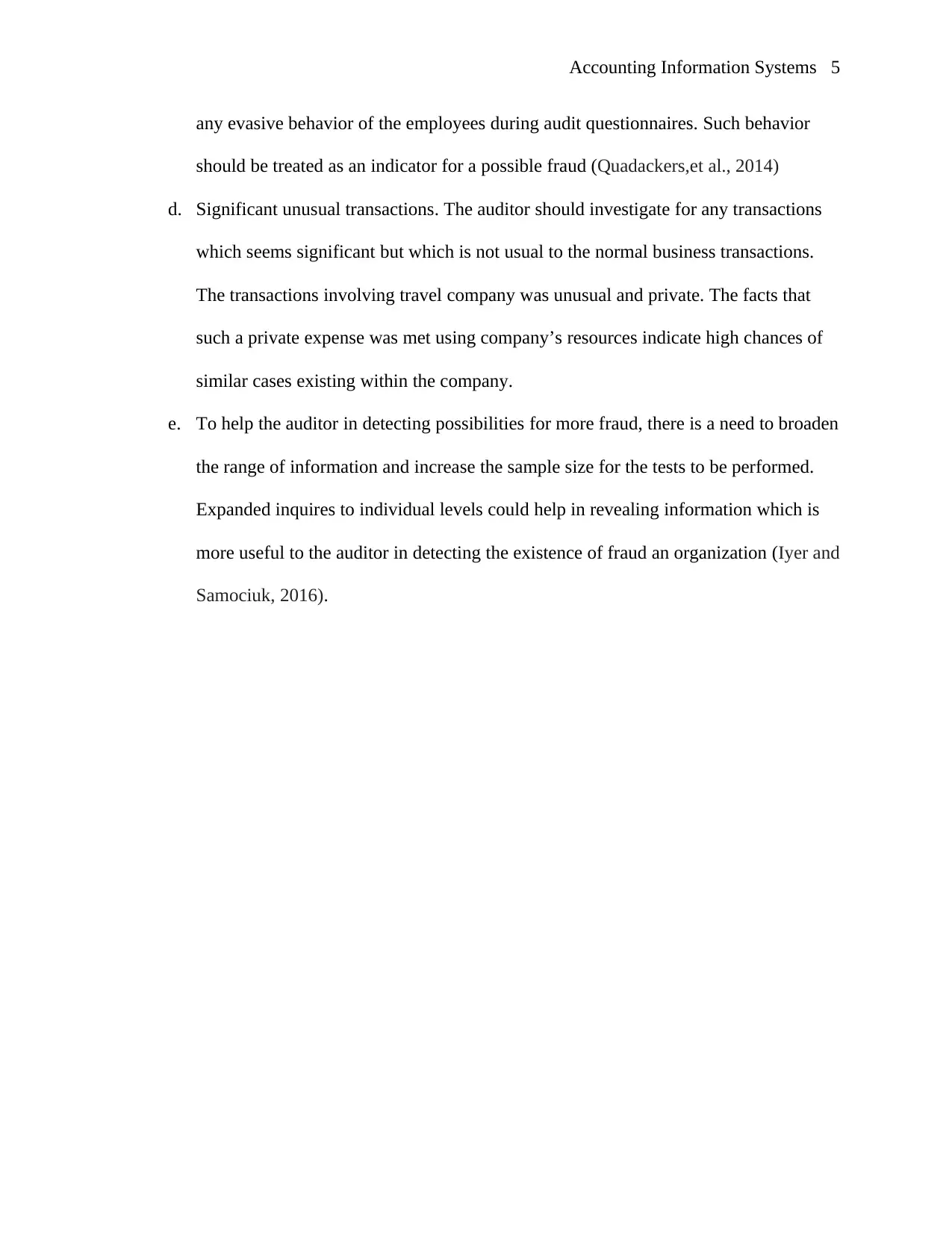
Accounting Information Systems 5
any evasive behavior of the employees during audit questionnaires. Such behavior
should be treated as an indicator for a possible fraud (Quadackers,et al., 2014)
d. Significant unusual transactions. The auditor should investigate for any transactions
which seems significant but which is not usual to the normal business transactions.
The transactions involving travel company was unusual and private. The facts that
such a private expense was met using company’s resources indicate high chances of
similar cases existing within the company.
e. To help the auditor in detecting possibilities for more fraud, there is a need to broaden
the range of information and increase the sample size for the tests to be performed.
Expanded inquires to individual levels could help in revealing information which is
more useful to the auditor in detecting the existence of fraud an organization (Iyer and
Samociuk, 2016).
any evasive behavior of the employees during audit questionnaires. Such behavior
should be treated as an indicator for a possible fraud (Quadackers,et al., 2014)
d. Significant unusual transactions. The auditor should investigate for any transactions
which seems significant but which is not usual to the normal business transactions.
The transactions involving travel company was unusual and private. The facts that
such a private expense was met using company’s resources indicate high chances of
similar cases existing within the company.
e. To help the auditor in detecting possibilities for more fraud, there is a need to broaden
the range of information and increase the sample size for the tests to be performed.
Expanded inquires to individual levels could help in revealing information which is
more useful to the auditor in detecting the existence of fraud an organization (Iyer and
Samociuk, 2016).
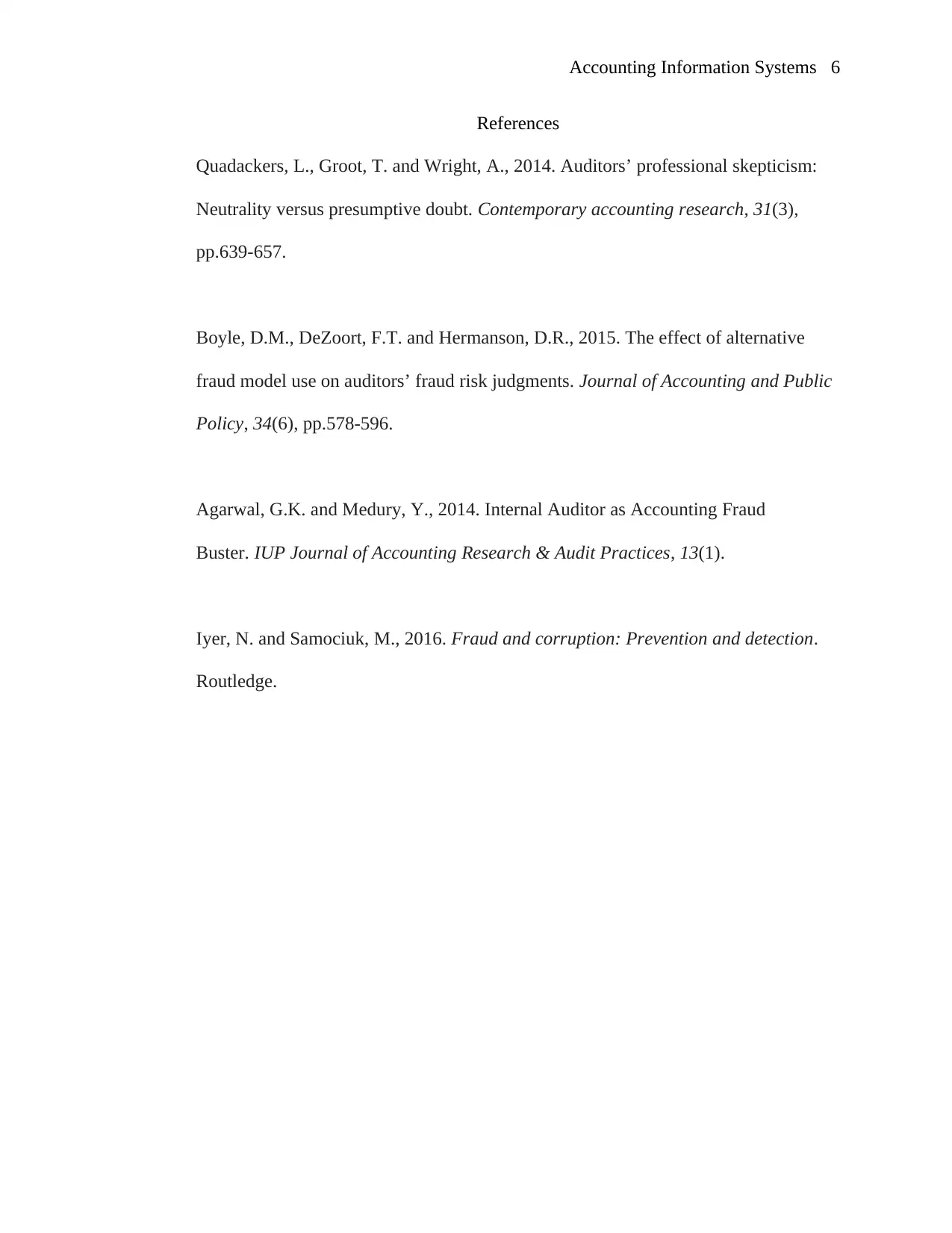
Accounting Information Systems 6
References
Quadackers, L., Groot, T. and Wright, A., 2014. Auditors’ professional skepticism:
Neutrality versus presumptive doubt. Contemporary accounting research, 31(3),
pp.639-657.
Boyle, D.M., DeZoort, F.T. and Hermanson, D.R., 2015. The effect of alternative
fraud model use on auditors’ fraud risk judgments. Journal of Accounting and Public
Policy, 34(6), pp.578-596.
Agarwal, G.K. and Medury, Y., 2014. Internal Auditor as Accounting Fraud
Buster. IUP Journal of Accounting Research & Audit Practices, 13(1).
Iyer, N. and Samociuk, M., 2016. Fraud and corruption: Prevention and detection.
Routledge.
References
Quadackers, L., Groot, T. and Wright, A., 2014. Auditors’ professional skepticism:
Neutrality versus presumptive doubt. Contemporary accounting research, 31(3),
pp.639-657.
Boyle, D.M., DeZoort, F.T. and Hermanson, D.R., 2015. The effect of alternative
fraud model use on auditors’ fraud risk judgments. Journal of Accounting and Public
Policy, 34(6), pp.578-596.
Agarwal, G.K. and Medury, Y., 2014. Internal Auditor as Accounting Fraud
Buster. IUP Journal of Accounting Research & Audit Practices, 13(1).
Iyer, N. and Samociuk, M., 2016. Fraud and corruption: Prevention and detection.
Routledge.
⊘ This is a preview!⊘
Do you want full access?
Subscribe today to unlock all pages.

Trusted by 1+ million students worldwide
1 out of 6
Related Documents
Your All-in-One AI-Powered Toolkit for Academic Success.
+13062052269
info@desklib.com
Available 24*7 on WhatsApp / Email
![[object Object]](/_next/static/media/star-bottom.7253800d.svg)
Unlock your academic potential
Copyright © 2020–2025 A2Z Services. All Rights Reserved. Developed and managed by ZUCOL.





